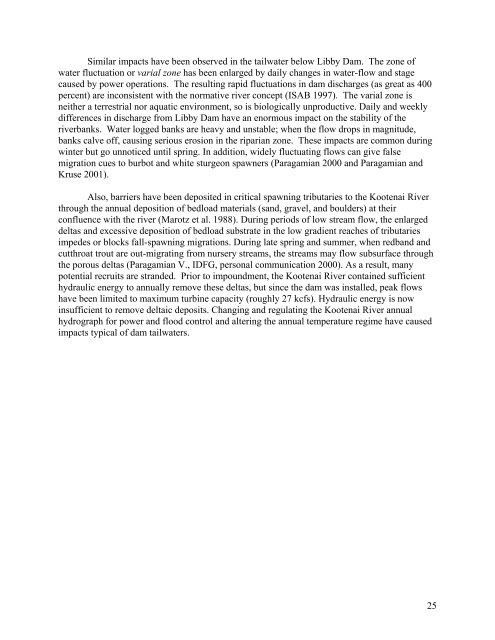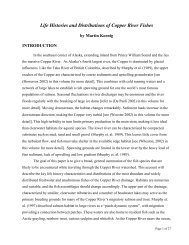Mitigation for the Construction and Operation of Libby Dam
Mitigation for the Construction and Operation of Libby Dam
Mitigation for the Construction and Operation of Libby Dam
You also want an ePaper? Increase the reach of your titles
YUMPU automatically turns print PDFs into web optimized ePapers that Google loves.
Similar impacts have been observed in <strong>the</strong> tailwater below <strong>Libby</strong> <strong>Dam</strong>. The zone <strong>of</strong><br />
water fluctuation or varial zone has been enlarged by daily changes in water-flow <strong>and</strong> stage<br />
caused by power operations. The resulting rapid fluctuations in dam discharges (as great as 400<br />
percent) are inconsistent with <strong>the</strong> normative river concept (ISAB 1997). The varial zone is<br />
nei<strong>the</strong>r a terrestrial nor aquatic environment, so is biologically unproductive. Daily <strong>and</strong> weekly<br />
differences in discharge from <strong>Libby</strong> <strong>Dam</strong> have an enormous impact on <strong>the</strong> stability <strong>of</strong> <strong>the</strong><br />
riverbanks. Water logged banks are heavy <strong>and</strong> unstable; when <strong>the</strong> flow drops in magnitude,<br />
banks calve <strong>of</strong>f, causing serious erosion in <strong>the</strong> riparian zone. These impacts are common during<br />
winter but go unnoticed until spring. In addition, widely fluctuating flows can give false<br />
migration cues to burbot <strong>and</strong> white sturgeon spawners (Paragamian 2000 <strong>and</strong> Paragamian <strong>and</strong><br />
Kruse 2001).<br />
Also, barriers have been deposited in critical spawning tributaries to <strong>the</strong> Kootenai River<br />
through <strong>the</strong> annual deposition <strong>of</strong> bedload materials (s<strong>and</strong>, gravel, <strong>and</strong> boulders) at <strong>the</strong>ir<br />
confluence with <strong>the</strong> river (Marotz et al. 1988). During periods <strong>of</strong> low stream flow, <strong>the</strong> enlarged<br />
deltas <strong>and</strong> excessive deposition <strong>of</strong> bedload substrate in <strong>the</strong> low gradient reaches <strong>of</strong> tributaries<br />
impedes or blocks fall-spawning migrations. During late spring <strong>and</strong> summer, when redb<strong>and</strong> <strong>and</strong><br />
cutthroat trout are out-migrating from nursery streams, <strong>the</strong> streams may flow subsurface through<br />
<strong>the</strong> porous deltas (Paragamian V., IDFG, personal communication 2000). As a result, many<br />
potential recruits are str<strong>and</strong>ed. Prior to impoundment, <strong>the</strong> Kootenai River contained sufficient<br />
hydraulic energy to annually remove <strong>the</strong>se deltas, but since <strong>the</strong> dam was installed, peak flows<br />
have been limited to maximum turbine capacity (roughly 27 kcfs). Hydraulic energy is now<br />
insufficient to remove deltaic deposits. Changing <strong>and</strong> regulating <strong>the</strong> Kootenai River annual<br />
hydrograph <strong>for</strong> power <strong>and</strong> flood control <strong>and</strong> altering <strong>the</strong> annual temperature regime have caused<br />
impacts typical <strong>of</strong> dam tailwaters.<br />
25
















